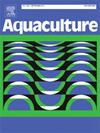基于生殖谱系的大规格中华绒螯蟹后代分子优势分析
IF 3.9
1区 农林科学
Q1 FISHERIES
引用次数: 0
摘要
本研究全面分析了中华绒螯蟹不同体型亲本所产幼体在两个生命早期阶段(受精卵和巨蟹)以及对应亲本生殖器官(睾丸、附属腺体和卵巢)的基因表达差异。结果表明,子代的发育优势主要由母系遗传,而抗逆性和味道优势则主要由父系遗传。具体而言,研究人员观察到,体型较大的雌蟹卵巢表达了许多与激素合成和代谢有关的基因,如 CYP15A1 和 CYP3A4,它们参与幼体激素的生物合成和代谢。在抗逆性方面,我们的研究发现,与氧化还原酶活性相关的基因,如ALDH3A2和PTGR2,在大规格雄蟹的睾丸和附属腺体中显著上调。这些基因参与了抵御外部压力和病原体入侵的关键生化途径,为后代提供了更强的抵抗力基础。此外,我们在风味性状方面的研究发现,GLUL和AGXT2等参与脂质、碳水化合物和氨基酸代谢的基因在大规格蟹的附属腺体中高度表达。本研究系统地探讨了大规格后代在发育、抗逆性和风味方面的潜在分子水平优势,并将这些优势与生殖器官的分子特征进行了比较,总结了可能表明这些优势的遗传模式。本文章由计算机程序翻译,如有差异,请以英文原文为准。
Analysis of molecular advantages in offspring of large-sized Chinese mitten crabs based on reproductive lineage
This study comprehensively analyzed gene expression differences between offsprings from varying parental sizes in the Chinese mitten crab (Eriocheir sinensis) during two early-life stages (fertilized eggs and megalopae) and corresponding their parental reproductive organs (testes, accessory glands, and ovaries). The mean ± SD (N=30) wet weights for the larger-sized male and female parental groups were 358.93 ± 4.93 g and 255.82 ± 3.45 g, respectively; For the smaller-sized groups were 142.55 ± 4.52 g and 93.97 ± 3.98 g. The findings indicate that offspring developmental advantages are predominantly inherited maternally, while resistance to stress and flavor advantages are primarily passed on from the paternal side.
In detail, it was observed that the ovaries of larger-sized female crabs expressed numerous genes related to hormone synthesis and metabolism, such as CYP15A1 and CYP3A4, which are involved in the biosynthesis and metabolism of juvenile hormones. Moreover, these genes play a crucial role in regulating the molting and metamorphosis processes, as well as the development of certain sensory abilities such as visual and tactile senses in the crabs, thereby aiding offspring in exhibiting superior physiological and structural characteristics during growth and development phases.
In terms of resistance to stress, our research identified that genes associated with oxidoreductase activity, such as ALDH3A2 and PTGR2, were significantly upregulated in the testes and accessory glands of larger-sized male crabs. These genes are involved in key biochemical pathways that defend against external stressors and pathogenic invasions, providing enhanced resistance foundations for the offspring. Additionally, our findings on flavor traits revealed that genes like GLUL and AGXT2, which were involved in lipid, carbohydrate, and amino acid metabolism, were highly expressed in the accessory glands of larger-sized crabs. These genes enhance the crabs' flavor by improving the synthesis and breakdown of key flavor components, contributing to a richer taste profile.
This study systematically explores the potential molecular-level advantages of larger-sized offspring in development, stress resistance, and flavor, comparing these to the molecular characteristics of the reproductive organs and summarizing the genetic patterns that may suggest these advantages.
求助全文
通过发布文献求助,成功后即可免费获取论文全文。
去求助
来源期刊

Aquaculture
农林科学-海洋与淡水生物学
CiteScore
8.60
自引率
17.80%
发文量
1246
审稿时长
56 days
期刊介绍:
Aquaculture is an international journal for the exploration, improvement and management of all freshwater and marine food resources. It publishes novel and innovative research of world-wide interest on farming of aquatic organisms, which includes finfish, mollusks, crustaceans and aquatic plants for human consumption. Research on ornamentals is not a focus of the Journal. Aquaculture only publishes papers with a clear relevance to improving aquaculture practices or a potential application.
 求助内容:
求助内容: 应助结果提醒方式:
应助结果提醒方式:


